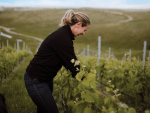Vintage 2024: Auckland
Kumeu River's 2024 harvet was done and dusted by mid-March, with light crops ripening quickly in the dry and warm conditions.
"At the top end, New Zealand Chardonnay has never been better."
Few would argue with this statement on its own merits, and fewer again with the man making it - Michael Brajkovich MW. Michael's family winery Kumeu River has been instrumental in putting New Zealand Chardonnay on the radar of wine lovers at home and abroad, and continues to be a benchmark many local winemakers look to when crafting their own wines. It's clear that the variety is where Michael's heart lies. "Chardonnay produces the best dry white wines in the world. Over several hundred years its versatility and sheer quality in a variety of vineyard environments has prove that beyond doubt."
Michael's grandparents Mick and Kate emigrated from Croatia in the 1930s, part of a Dalmatian diaspora that created an enduring legacy for New Zealand's wine industry. They purchased land at Kumeu in 1944, naming it San Marino after the itinerant 3rd Century Croation saint, Marinus (it became Kumeu River in 1989, the year that Michael also became New Zealand's first Master of Wine). Michael's father Maté was joined by wife Melba in the 1950s and these days Michael and his three siblings, together with Melba, run the estate. By the 1960s the winery had become well known for its predominantly fortified wines, but Maté was always keen on table wines. "My father was a very forward-thinking man, and it was his dream to produce just two outstanding wines: one red and one white." To this end, in 1982 they planted Cabernets Sauvignon and Franc, as well as Sauvignon Blanc and Chardonnay.
They bought another 40 hectares when Corban Wines sold their Auckland holdings, the main attraction being an 8ha block of Merlot, at the time the biggest in New Zealand. After graduating as Dux from Roseworthy College in 1981, Michael had secured a vintage position with Château Pétrus’ proprietors Moueix, and spent the 1983 harvest soaking up knowledge at St Émilion’s Château Magdelaine (now known as Ch. Bélair-Monange). "We had very high hope for Merlot in Kumeu," he says. "However, as the years passed it became very clear that our cool conditions do not allow for consistency in ripening the Cabernets, or indeed Merlot. Sauvignon Blanc also struggled with botrytis most years, but Chardonnay performed admirably in every season. Under our cloudy, cool weather conditions it quickly became obvious that the early-season Chardonnay always had the best chance of producing ripe grapes and outstanding wine. Several decades of experience has proven that initial observation to be very correct." Indeed.
Michael's winemaking combines intellect and judicious technical skill with thoughtful innovation. “When I joined the team in 1982 our main production was ‘Sherry’ and ‘Port’ style wines made principally from Palomino. White table wine was starting to become a major item, in particular Müller-Thurgau from Gisborne. During the ‘80s, sweeping change was happening to wine in New Zealand; by 1986 we had ceased selling fortifieds, and Chardonnay had already become our main focus.”
While Maté had grown Mendoza Chardonnay since the 1960s, leaf roll virus was rife. Their 1982 plantings gave them access to newer clones and rootstocks, and Michael’s time in Burgundy “taking copious notes” showed him a different approach. “Standard procedure was to ferment the juice cool in a stainless-steel tank using one of the newest selected yeast cultures; oak ageing to add wood seasoning was increasingly common. This produced vibrant fruity wines in their youth with a healthy dose of oak, but which invariably aged quickly and often oxidised their way to an early decline.” Encouraged by Maté, who said, “you’ve got the knowledge and techniques, let’s try something different here”, Michael introduced numerous changes. He says most of these “were considered quite radical” and they didn’t talk about indigenous yeast for ferments as “people would have thought we were mad”.
The techniques that are the norm now – hand harvesting, whole-bunch pressing, cold settling, warmer fermentation temperatures, barrel fermentation, French oak, malolactic fermentation, and lees ageing in barrel – were initially not well received. “Early Kumeu River Chardonnays were panned in local wine competitions for being so radically different, and this made us very wary of entering wine shows. Gradually the message got through, particularly following such kudos as being in the Wine Spectator’s Top 100 on six occasions.” There’s no shortage of fans these days, and Kumeu River has famously upset top Burgundies when head-to-head in overseas blind tastings. Michael says recognition from Jancis Robinson and James Suckling in particular means they now need to allocate their wines globally.
Kumeu River produces six Chardonnays, four of which are Single Vineyard expressions, including one from their Hawke’s Bay vineyard, Ray’s Road, purchased in 2017. Urban sprawl severely constrained their ability to expand in Kumeu and Michael enjoys what the Hawke’s Bay fruit contributes to the estate blend, “a lifted peach-fruit character and palate richness to balance the mineral, earthy austerity of our Kumeu fruit”. The inland vineyard is planted mainly in Clone 95 on limestone slopes at 180-200m altitude. “Chardonnay is at its zesty, limey, mineral best on this soil … one certainly is reminded of the wines of Chablis.” Grapes are hand-harvested and transported to Kumeu for processing.
Kumeu River and Michael have undoubtedly helped change the way New Zealand produces Chardonnay, evidenced by the industry’s gradual adoption of most of the techniques mentioned above. “The popularity of ‘reductive’ styles of Chardonnay has also been a direct result of this,” Michael wryly observes. “Unfortunately some results come straight from the ‘if a little bit is good, then a whole lot must be great’ school of winemaking, which also used to afflict the use of oak.” He adds that there “still exists a very boring rump of ordinary wines that are either over-cropped, over-oaked or just very dull indeed.” Overall though, he’s encouraged by New Zealand’s Chardonnay progression. “Whereas in the past many Chardonnays were very similar and based on the model of Côte de Beaune, we are now seeing more diversity of style, with less oak, more zest, and greater drinkability when young. There is nowhere in New Zealand that has a truly hot, or even warm, climate. We are all dealing in cool climate viticulture with a variety that is well suited to it, and better suited than just about any other for making quality dry white wine.”
With Michael repeatedly on record waxing lyrical about Sherry and other fortified wines, perhaps we may yet see the return of a Kumeu River version ... what’s more certain is that he will continue to deliver many more world class Chardonnays for our enjoyment.

OPINION: Harvest begins, and almost immediately we start to get media enquiries about how the vintage is going and whether it…

OPINION: Rachael Cook is the smiling grape grower on this month’s cover, tending vines on the miniscule, beautiful and dream-driven vineyard…
New Zealand wine enthusiasts have a deepening understanding and growing appreciation of sparkling wine, says Mel Skinner, Chair of Méthode Marlborough…
One of the biggest mistakes wine marketers make is in assuming consumers are as passionate and knowledgeable about wine as…
Taking two sustainability awards at two events on a single evening felt like "true recognition" of the work Lawson's Dry…